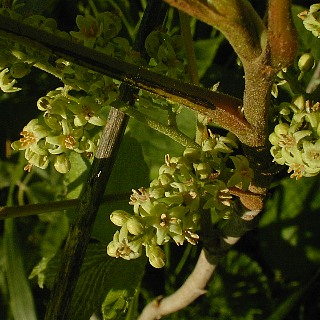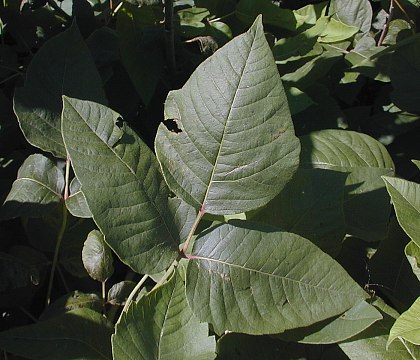Description:
This
perennial plant is either a shrub up to 3' tall or a woody vine
up to 60' long. The stems are initially light reddish green, but they
eventually become brown and woody. The woody stems are often covered
with coarse brown hairs, but sometimes they are hairless. As a vine,
aerial rootlets develop along the stems; these rootlets can cling to
tree bark, fences, walls, and other objects. The alternate compound
leaves are trifoliate and up to 1' long; they have long slender
petioles. The leaflets are up to 4" long and 2½" across. They are
cordate-ovate, ovate, or broadly elliptic and their margins are smooth,
slightly undulate, or slightly dentate. When teeth are present, they
are few in number and somewhat blunt. The upper surface of each leaf is
medium green and hairless, while the lower surface is pale green and
either slightly pubescent or hairless. Across from the compound leaves,
panicles of yellowish green flowers are sparingly produced. These
panicles are up to 4" long and across; they
are often irregular in
shape. Each
flower is about ¼" across, consisting of 5 green petals, 5 stamens, 5
sepals, and an ovary with a stout style. The petals are
triangular-shaped and recurved, while the sepals are smaller in size
and deciduous. The stamens have slender white filaments with yellowish
brown anthers. The peduncles and pedicels of the flowers are often
pubescent. An individual plant may have perfect flowers, staminate
flowers only, pistillate flowers only, or both staminate and pistillate
flowers. The blooming period occurs from late spring to mid-summer and
lasts about 2-3 weeks. Each flower is replaced by a drupe that contains
a single seed (stone). This drupe is dull white and about ¼" across; it
has a smooth waxy surface. The large seed is ovoid in shape and dull
white; there are a few grey stripes across its surface. The drupes
mature during the fall and can persist through the winter. The root
system produces a woody taproot and long rhizomes; the rhizomes produce
vegetative offsets.
to 4" long and across; they
are often irregular in
shape. Each
flower is about ¼" across, consisting of 5 green petals, 5 stamens, 5
sepals, and an ovary with a stout style. The petals are
triangular-shaped and recurved, while the sepals are smaller in size
and deciduous. The stamens have slender white filaments with yellowish
brown anthers. The peduncles and pedicels of the flowers are often
pubescent. An individual plant may have perfect flowers, staminate
flowers only, pistillate flowers only, or both staminate and pistillate
flowers. The blooming period occurs from late spring to mid-summer and
lasts about 2-3 weeks. Each flower is replaced by a drupe that contains
a single seed (stone). This drupe is dull white and about ¼" across; it
has a smooth waxy surface. The large seed is ovoid in shape and dull
white; there are a few grey stripes across its surface. The drupes
mature during the fall and can persist through the winter. The root
system produces a woody taproot and long rhizomes; the rhizomes produce
vegetative offsets.
Cultivation:
Poison Ivy can be found in light shade to full sun, moist to dry
conditions, and various kinds of soil, including those that contain
loam, clay-loam, rocky material, or sand. This plant adapts to a
variety of conditions and can be very aggressive. It does not tolerate
periods of prolonged flooding.
Range & Habitat:
Poison Ivy is a common plant that occurs in all counties of Illinois
(see Distribution
Map), where it is native. Habitats include moist to dry
woodlands, sandy
woodlands, woodland openings, areas along woodland paths, thickets,
meadows, limestone glades, sand dunes, fence rows, and abandoned
fields. This ubiquitous plant can be found in both disturbed and higher
quality habitats. It usually doesn't wander far from wooded areas,
although sometimes it exists as an understory plant in tallgrass
prairies.
Faunal Associations:
The nectar and pollen of the flowers attract bees occasionally;
Robertson (1929) observed only Andrena crataegi.
The caterpillars of the following moths feed on the foliage: Amorbia
humerosana (Tortricid Moth sp.), Marathyssa basalis
(Light Marathyssa), and Paectes oculatrix (Eyed
Paectes). The seeds/fruit are eaten by many species of songbirds and
upland gamebirds (see Bird Table); woodpeckers and
flickers are especially attracted to the fruit. These birds help to
distribute the seeds far and wide. To a minor extent, the foliage,
branches, and fruit are eaten by the Black Bear, Cottontail Rabbit, and
White-Tailed Deer. These animals appear to be immune to the irritating
properties of the chemical agent, urushiol, in the foliage.

Photographic
Location:
Along an abandoned railroad near Urbana, Illinois, in an area that was
partially overgrown with small trees and shrubs.
Comments:
The foliage of Poison Ivy can irritate the skin of most people, causing
redness and blisters. This is caused by a reaction of the immune system
to urushiol. People who are immune to Poison Ivy when they are young,
can become sensitive to its irritating effects when they become older.
Only primates and hamsters are known to have allergic reactions to
Poison Ivy, while other animals appear to be immune to its effects. The
growth habit of Poison Ivy and the appearance of its leaflets can be
highly variable, which sometimes confuses people regarding its
identity. At one extreme, Poison Ivy can assume the form of a low
little-branched shrub with trifoliate leaves, while at the other
extreme it can assume the form of a long woody vine that can swallow up
trees. As a vine, its woody stems have a hairy appearance from the
abundant aerial rootlets and no tendrils are produced across from the
trifoliate leaves. Other woody vines produce simple leaves (e.g., Wild
Grapes and Moonseed) or they have compound leaves with 5 or more
leaflets (e.g., Virginia Creeper and Trumpet Creeper).